
GMDC: DEEP IMPACT THAT FOSTERS GROWTH AND HOPE
The Gujarat Mineral Development Corporation Ltd (GMDC) adopts an integrated approach to community development through its CSR activities
As one of India’s leading mining and mineral processing company, Gujarat Mineral Development Corporation Ltd (GMDC) understands its responsibility towards society and community. The five decades old company through its CSR arm Gramya Vikas Trust (GVT), not only been leading some very impactful CSR activities but has also been addressing crucial pain points for rural communities. The key thrust areas of GMDC’s CSR Include promotion of quality and inclusive education; bridging gaps in healthcare through access and availability; focused transformation through skill development; safe drinking water and sanitation; environment sustainability and ensuring climate action; and conservation of heritage, art & culture.
In an era where energy is both a necessity and a strategic asset, coal continues to play a pivotal role in driving industrial growth and powering nations. Recognising this critical need for secure, reliable and scalable energy resource, GMDC has acquired three coal blocks in Odisha namely Baitarani West & Kudanali Lubri in Chhendipada tehsil of Angul district and Burapahar in Hemgiri tehsil of Sundargarh district. It is aggressively progressing towards operationalization of mining.
While the acquisition of these coal blocks represents a significant milestone for GMDC, the real story lies in their transformative impact on the people and communities. Various pre-operative activities, including environmental and forest clearance, land acquisition, and resettlement and rehabilitation (R&R) activities, need to be completed before the coal mining operations commence.
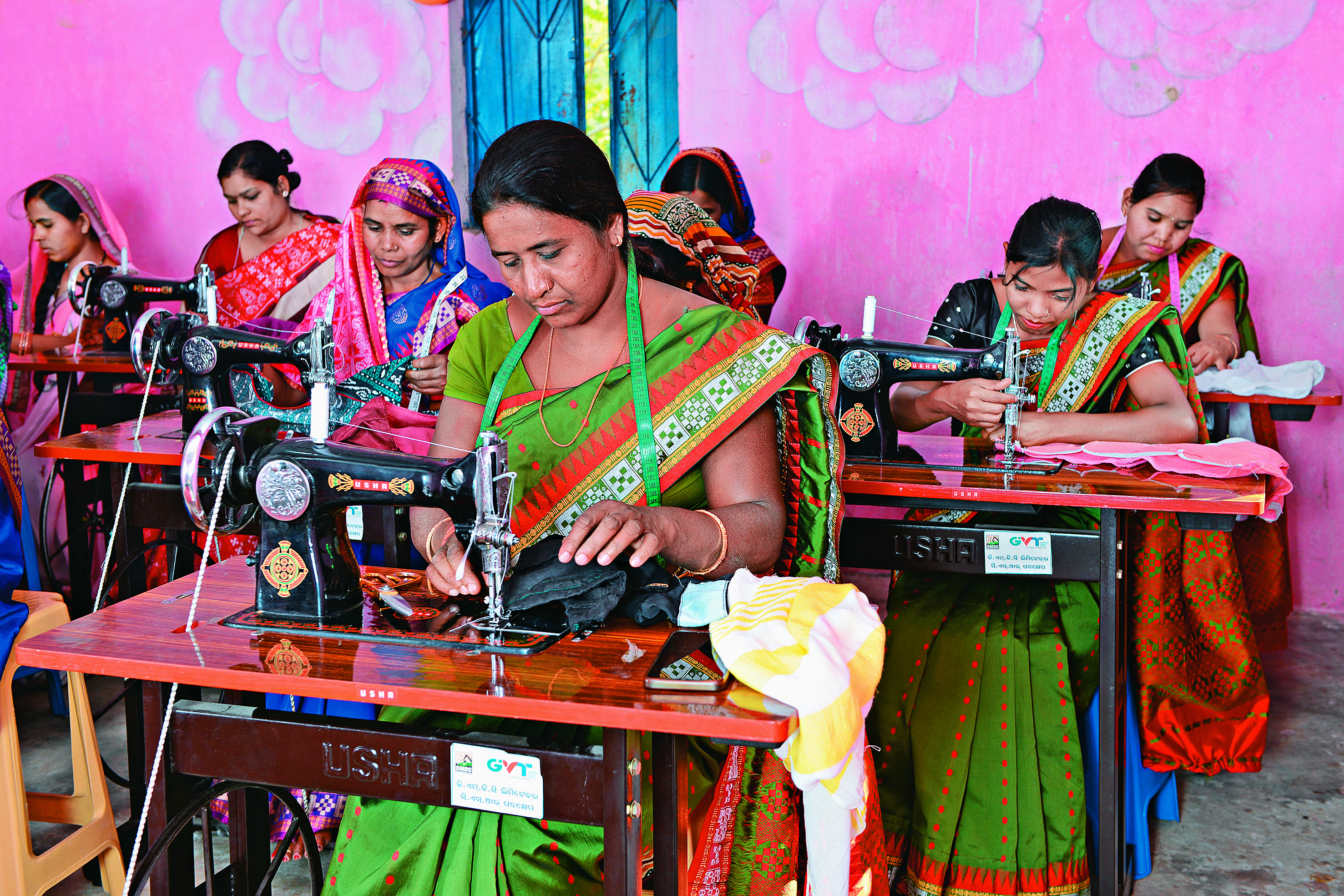
Women from Bhogra-Kachar village hone their skills under GMDC’s Tailoring Training Programme, using stitching machines to build sustainable livelihoods
GMDC’s R&R plan for Baitarani West exemplifies the commitment of GMDC towards the wellbeing of community. This initiative supports more than 1,500 families with housing, healthcare and community spaces, around its mining areas. To ensure smooth community engagement and to address the needs of stakeholders, GMDC has been successfully implementing CSR activities through GMDC-GVT.
Coal mining and its operations bring with it a wealth of employment opportunities, both direct and indirect. From skilled mining jobs to ancillary roles in logistics, construction and services, thousands of livelihoods will be created, offering stable incomes to local families, which otherwise struggled to earn a stable livelihood.
GMDC has facilitated training opportunities through two Samarthya centres: ADS Foundation in Rourkela, and Dr Reddy’s Foundation in Bhubaneswar.
GMDC’s Samarthya Programme at Bhubaneswar focuses on general duty assistant (GDA) training through Dr Reddy’s Foundation, where 31 girls have confidently completed the programme and are excited and ready for their future of building sustainable livelihoods and support their family.
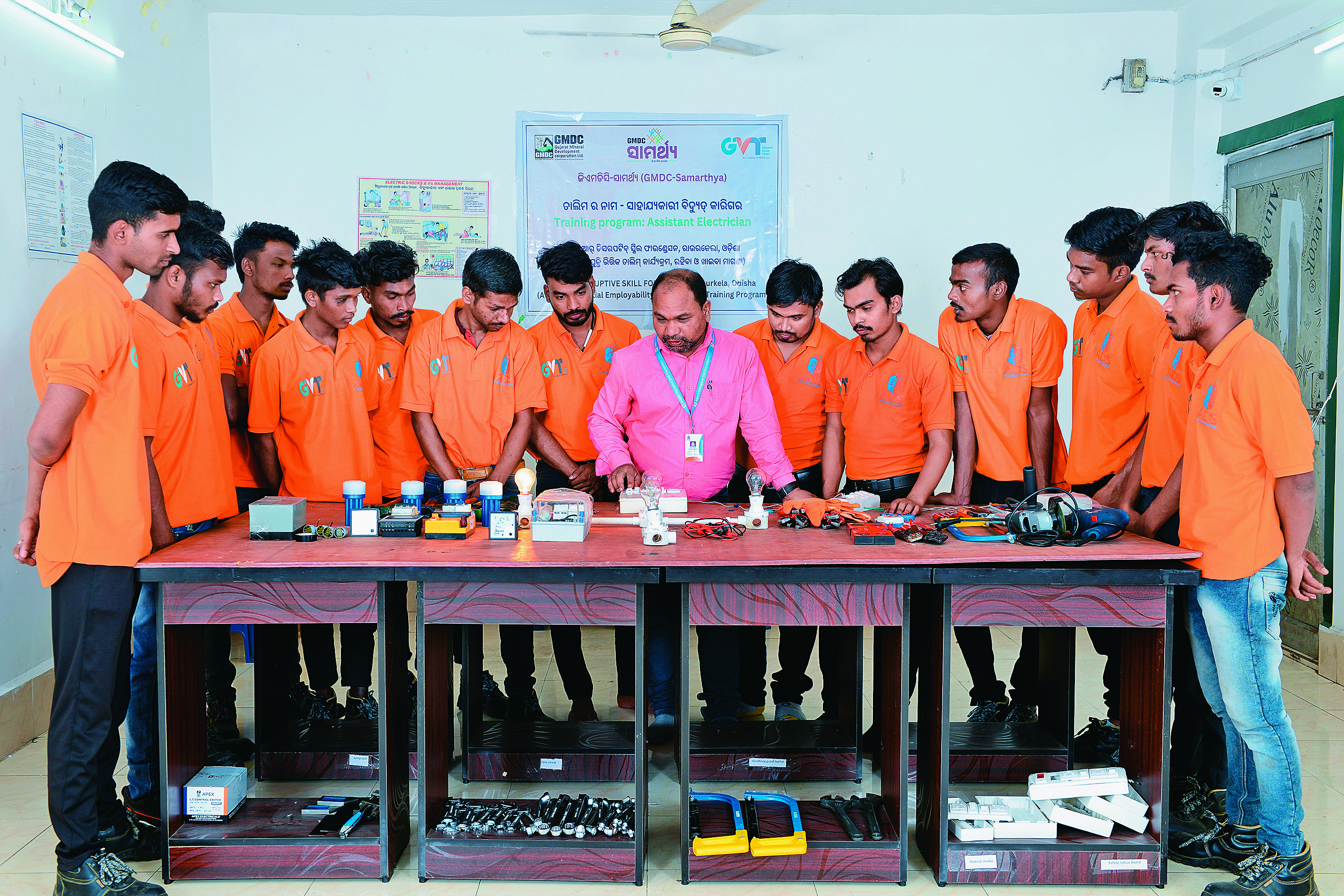
Hands-on training in Rourkela empowers youth with skills for sustainable employment under GMDC’s Samarthya initiative
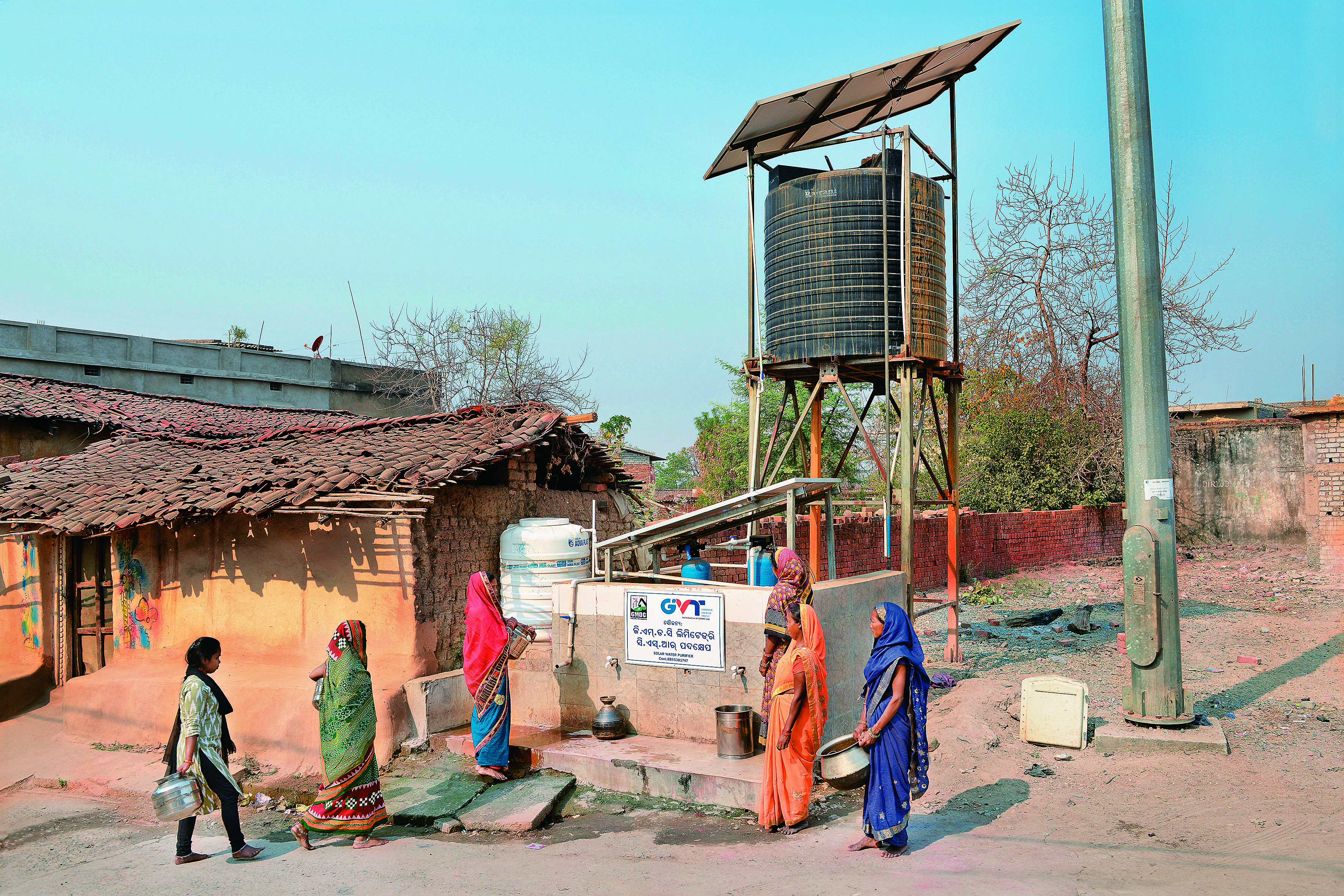
Access made easier—villagers collect clean water from GMDC’s solar-powered tap installation in Odisha
Eyes light up with wonderment, as Manasi Naik enthusiastically speaks about how she is prepared to enter the modern world and secure a job that would not only support her future, but also provide support to her family in Kumbharsahi village, where livelihood options have meant basic farming and meagre jobs.
Manasi’s batchmate Monalisa Garnaik is equally excited and looking forward to a brighter future. Monalisa comes from Podapada village of Chhendipada tehsil of Angul district.
In a video, Raja Jaypuria from Beldhipa village of Hemgiri tehsil recounts with happiness that he is undergoing the training to become an assistant electrician through the three-month course run by ADS Foundation at Rourkela and is guaranteed job placement after his exams. Deepak Kumar jostles for camera space to convey how lucky he felt when he found out about this course through a friend. He belongs to Jamkani village of Sundargarh district. Through Samarthya Program many such young men and women are gearing for better career opportunities.
Mornings in most villages would begin with getting potable water to cook a meal. Access to clean water was extremely tough for many villagers and often meant a long walk for just a pot of water from a well or a hand pump.
Radhika Kanvar, from Kunvarpada village of Hemgiri tehsil of Sundargarh district, conveys how grateful she is to GMDC for the installation of a solar water purifier, which provides clean drinking water to the villagers.
In the villages surrounding its coal mines, GMDC is ensuring that families are provided with primary health care and check-ups through the GMDCJan Chikitsa Seva (Mobile Medical Vans). These vans reach out to nearly 14,000 people across 48 villages and provide free medical consultations and organise over 500 camps bringing healthcare to their doorstep.
GMDC’s coal operations are not just about energy -- they are about transforming lives. In Hemgir and Chhendipada regions of Odisha, new panchayat buildings, community halls and high-mast lights have turned villages into bustling centres of activity. Solar lights in Baitarani West now brighten pathways for over 9,500 residents, while similar installations in Burapahar bring safety and convenience to nearly 4,500 people.
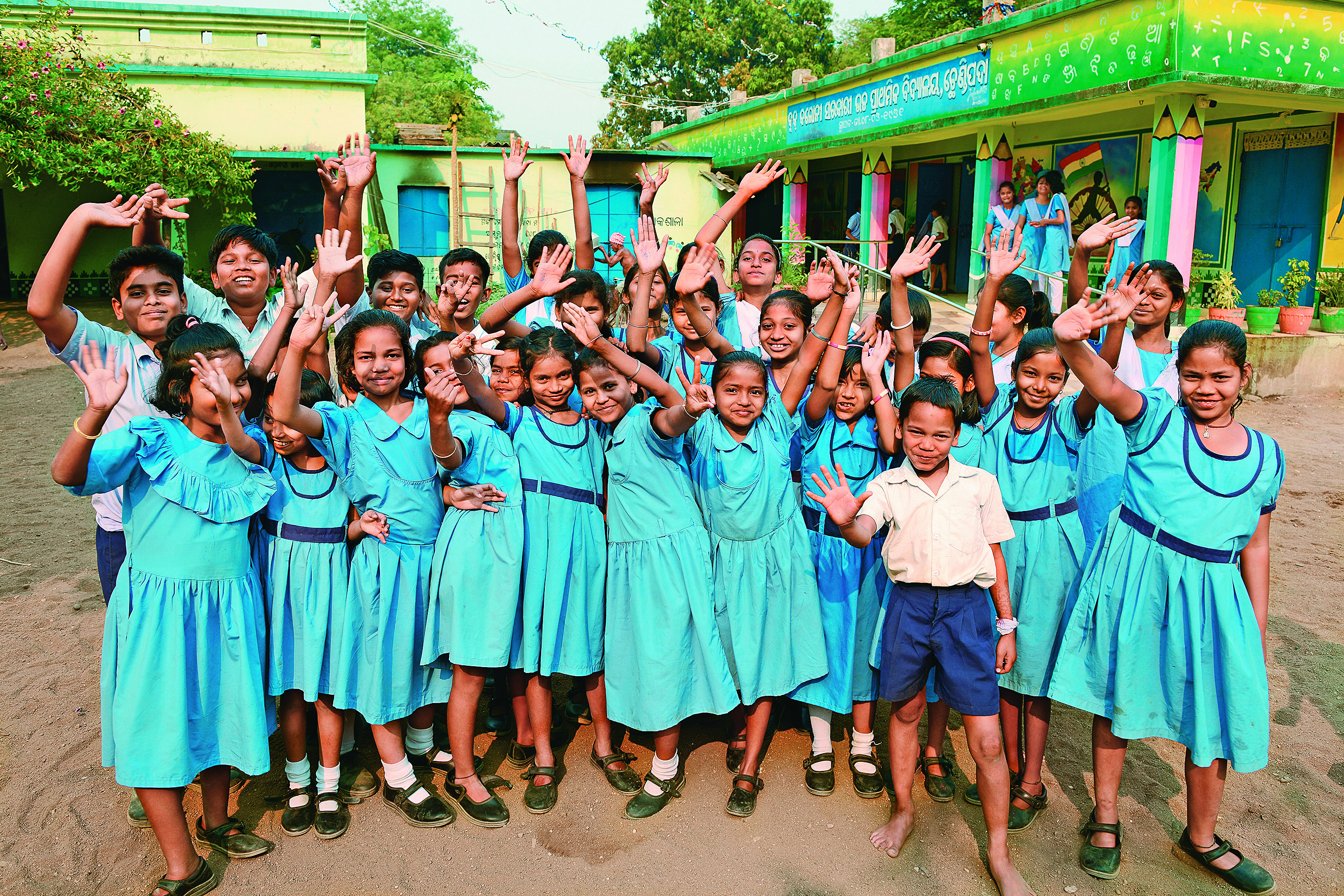
Children at Block Colony Government Upper Primary School, Chendipada ,Angul District , all excited about another day of learning
The Tailoring Training Programme has provided 10 stitching machines for income generating activities for 30 women’s self-help group (SHG) members in Bhogra-Kachar and surrounding villages, as revealed through short videos of Saraswati Shah and Ranjana Dehri of Bhogra-Kachar village.
Education, too, is becoming a cornerstone for upliftment of communities. GMDC’s schooling initiatives are supporting over 3,700 students, many of whom are the first in their families to attend school. Girl students, often at risk of dropping out due to lack of resources, now receive educational kits and books, ensuring they stay on the path to a brighter future. For most families, purchasing a notebook for their children is a cost too dear; to address this, GMDC distributes over 24,500 notebooks to these children.
Picture this: A predominantly rural population of 66,000, with a dominance of Bhil tribe (Vasava and Rathwa) community. This is Kawant tehsil in Chhottaudepur district, Gujarat, and it has the community’s first Englishmedium school. What it means for parents from this region to see their children going to such a school, is best witnessed, since words fall short.
Jatin B from Ambadungar village smiles from ear to ear and says, “It’s a blessing for us to have our children go to an English-medium school, and we are extremely happy and grateful for GMDC’s initiative. Today, we feel our children can go further than we could have ever dreamed of, and uplift our entire community.”
The school based within the Kadipani campus aims to help educate the local community, along with GMDC employees’ children under one roof. This also helps expose children to each other’s cultures and understanding, broadening their horizons and teaching them more than what is prescribed in their syllabi.
The school is spread across 29,000 sq ft and has 15 classrooms. The access of the school is complemented by daycare facilities such as mid-day meals, pickup and drop facility, and extracurricular activities, amongst several others.
Nilesh Jhala, the school principal, shares that through perseverance, community engagement, and the establishment of remedial programmes, significant educational advancements have been made. It wasn’t easy in the beginning and the school faced several challenges initially, particularly concerning students’ readiness due to a lack of pre-primary education, language barrier, and lack of community awareness about the importance of education.
“Since many children lacked formal education, they faced barriers when transitioning to school, which required innovative solutions from Atul Vidyalaya,” says Jhala, explaining the challenge of integrating students who lack prior schooling highlights, especially in underserved communities. “But establishing communication via community meetings transformed parental perceptions, enhancing their involvement in children’s education,” he says.
The rapid rise in student enrolment from 80 to 150 in just a year marks a significant achievement for the school. It indicates the community’s shifting perception and willingness to invest in education. Such positive enrolment trends suggest that innovation in teaching methods and a strong support system attract families seeking better educational outcomes for their children.
The school’s future plans to expand from kindergarten to higher grades align with the community’s educational aspirations. This vision illustrates an understanding of the cumulative nature of education. Thus, a structured approach to scaling educational offerings is paramount to sustain community engagement and facilitate a comprehension of the importance of lifelong learning.
Danabhai Rabari, a sheep herder who belongs to the Rabari community, lives in Varmanangar in Gujarat, and is a much-relieved man, just like several others in the area.
Under the Gramya Vikas Trust (GVT) , GMDC has initiated a Mobile Medical Unit (MMU) service in collaboration with Apollo Health Enterprise Limited to bring free healthcare to surrounding communities. “Earlier, if anyone in the area had any issues, even if it was a body ache, we had to spend Rs 1,000 for travel and another Rs 800 for doctors’ fee and medicines. But now, every couple of weeks, we have the MMU come to our locality.” Danabhai talks about how it was the MMU doctor who diagnosed his father’s diabetes and hypertension. “We now get medicines also from them. I have a lot of faith in this programme since it has helped a lot of people in our community,” he concludes.
Not every ailment can be sorted through an MMU and for that, GVT has started a hospital in collaboration with Apollo Health Enterprise Limited.
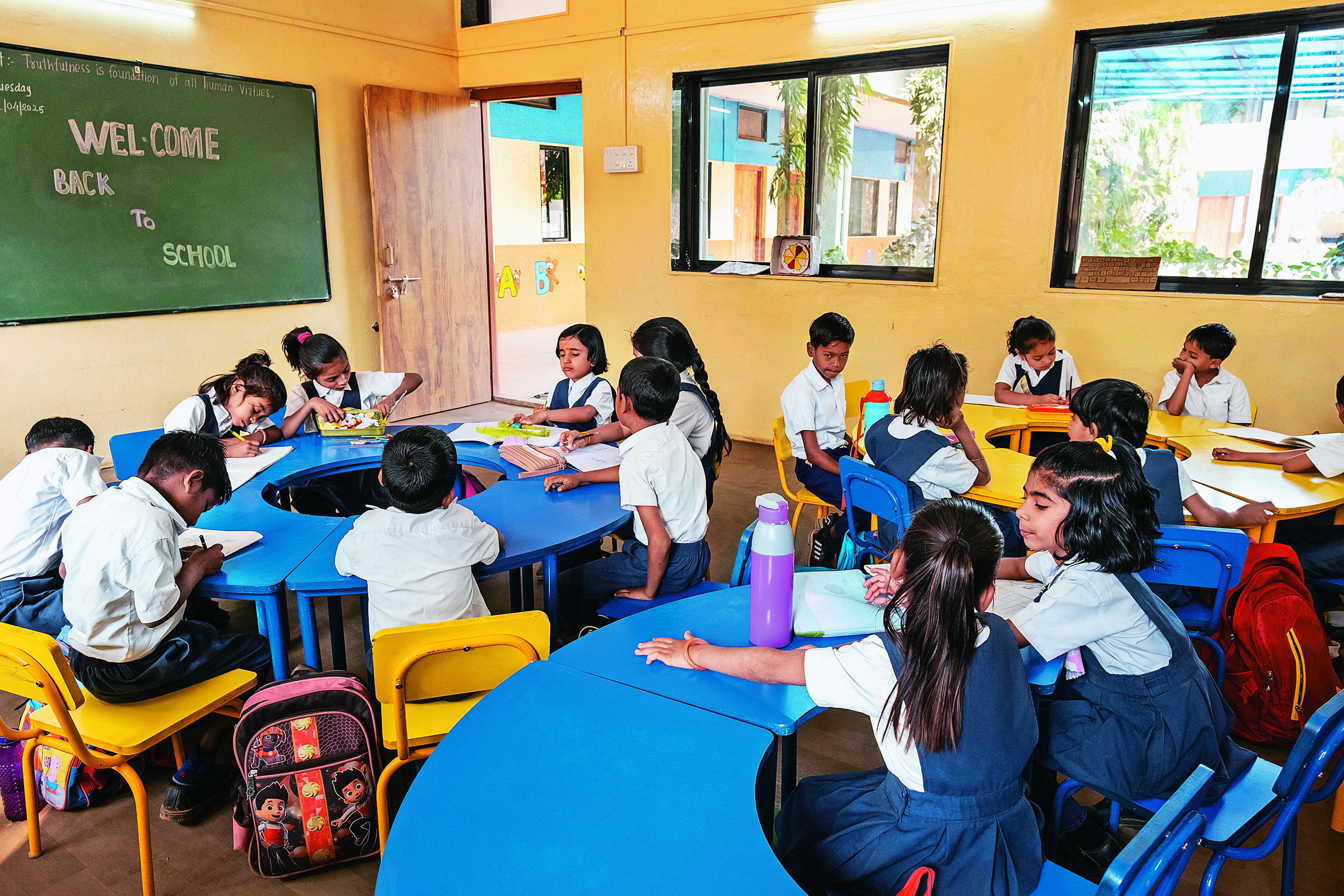
Atul Vidyalaya, Kadipani,offers a spacious, English-medium environment, fostering growth and learning for all students
This hospital is open for anyone from the community and has multiple facilities such as emergency; dental ward; labour, delivery, and Recovery (LDR) room; and multiple labs for blood tests, pharmacy and consultation rooms.
The Kadipani campus by itself houses at least 150 families that are associated with GMDC, which includes officials, employees and contractors that work on various projects around the vicinity. Apart from the campus, it is surrounded by 13 villages and has a community population of over 25,000. Understandably, it is always busy. But guess who is not complaining?
Dr Hitesh from the hospital says, “I have seen multiple kinds of cases that involve viral infections, cold and fever, and have also come across cases of skin conditions like dermatitis, tinea, and eczema, amongst others. Due to a lack of education, communities have a difficult time maintaining appropriate hygiene practices, and we help them understand its importance.” He says that with regular consultations and medical assistance, they are seeing promising results and positive behavioural change within the community.
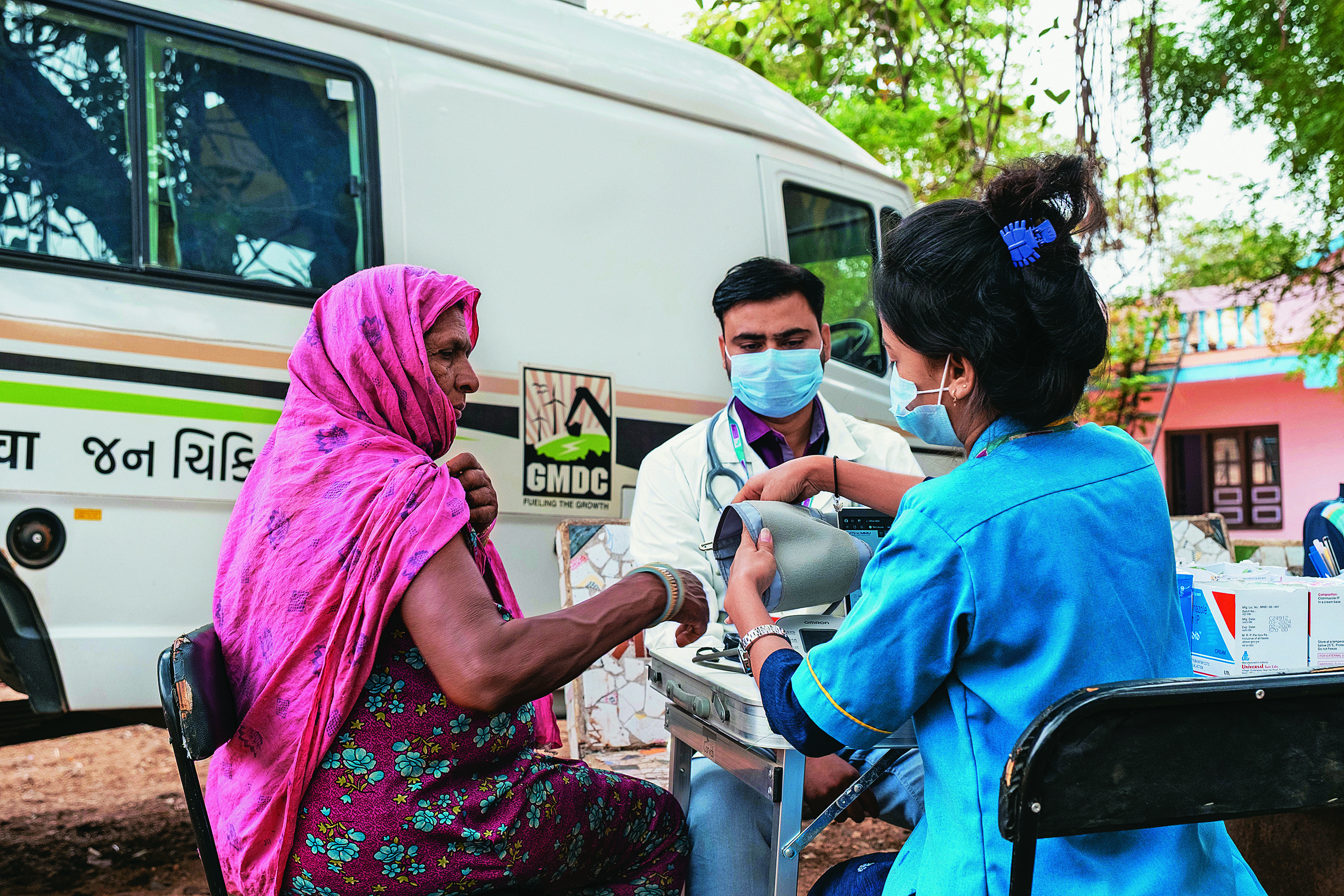
A woman receives a vital check-up through the Jan Chikitsa Seva Mobile Medical Unit in Varmanangar, bringing free healthcare and hope to rural communities
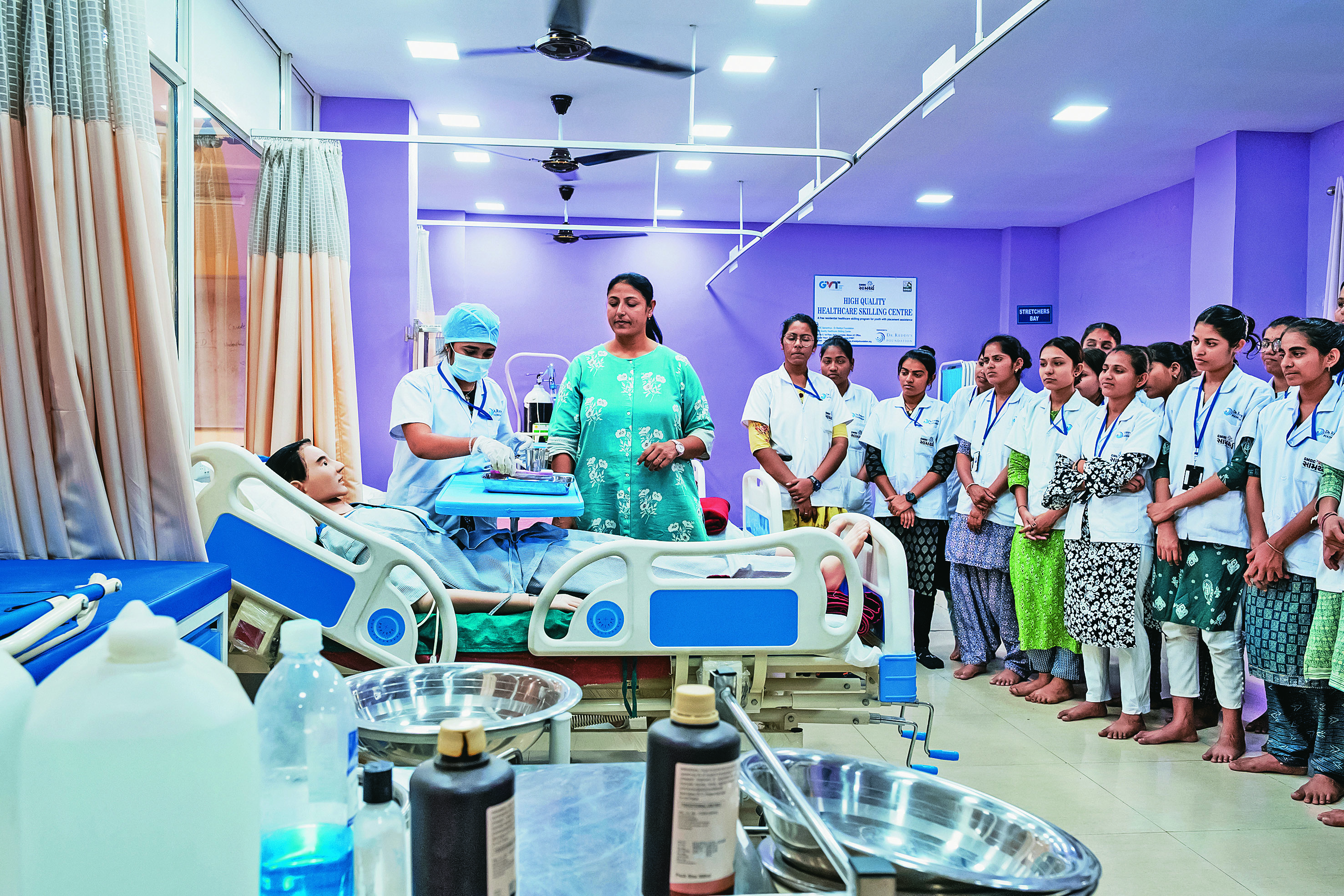
Practical healthcare training at Kadipani Hospital, a GMDC-Apollo collaboration, empowering future professionals
The initiative highlights the importance of skill training in achieving economic empowerment. A notable 78% of the beneficiaries are youth aged between 18 to 22, reflecting the initiative’s focus on early career development. The programme has also achieved an impressive 86% placement rate, connecting trainees with meaningful job opportunities in reputed companies.
Twelve courses are offered, including those for general duty assistant, CNC operator turning, and solar panel installation technician amongst others. These have been developed in consultation with industry experts to align with current market demands and provide practical, employable skills.
Training modules integrate classroom instruction with hands-on practice, realworld case studies, and on-the-job exposure. Residential facilities are provided and soft skills such as communication, teamwork, leadership, and empathy are woven into the curriculum, making participants more adaptable and workplace-ready.
The programme’s impact is best reflected through its beneficiaries. Darshan Rajgor, now working as a solar panel technician at Kosol Energie, shares, “From where I come, after our education, we have limited job roles such as daily wage labour, which means hard physical work with meagre pay and no growth.” What’s worse, if they start a small business and it fails, these young people are left with debt, increasing their financial challenges.
“With the help of the Samarthya Project, I have not only been able to break free, but have also learned new skills that can take me ahead in life. I am a technician at a solar farm, and my ambition is to run my own farm. In a village, someone my age will earn between Rs 6,000 and Rs 7,000 a month, but here, I earn Rs.12,000 at base level, with the promise of a secure future.”
The initiative also resonates with the trainers who mentor these youth. Asmita Acharya, a general duty assistant trainer in Bhuj, highlights the change: “We hold sessions with parents to help them understand the nature of work their children are learning. We not only train the students as a general duty assistant but also equip them with soft skills and body language methods to help and assist patients. I’ve had parents greet me with happiness and pride because of how far their children have come, and thank the project.”
Upon completion, participants receive certifications from the Sector Skill Council, Government of India — credentials recognised by industry partners across the country. The programme also provides dedicated placement support, ensuring a smooth transition into the workforce. By bridging the gap between education and employment, the GMDC-GVT Samarthya Programme not only equips youth with practical skills but also fosters confidence and independence.
GMDC’s impact goes far beyond the coal and lignite it mines. Its projects are about creating an ecosystem where progress is shared. The infrastructure, healthcare, education as well as cultural efforts in Odisha paint a picture of a company that sees its communities as partners in growth. GMDC is lighting up not just homes but also hopes, proving that powering energy can also mean empowering lives.
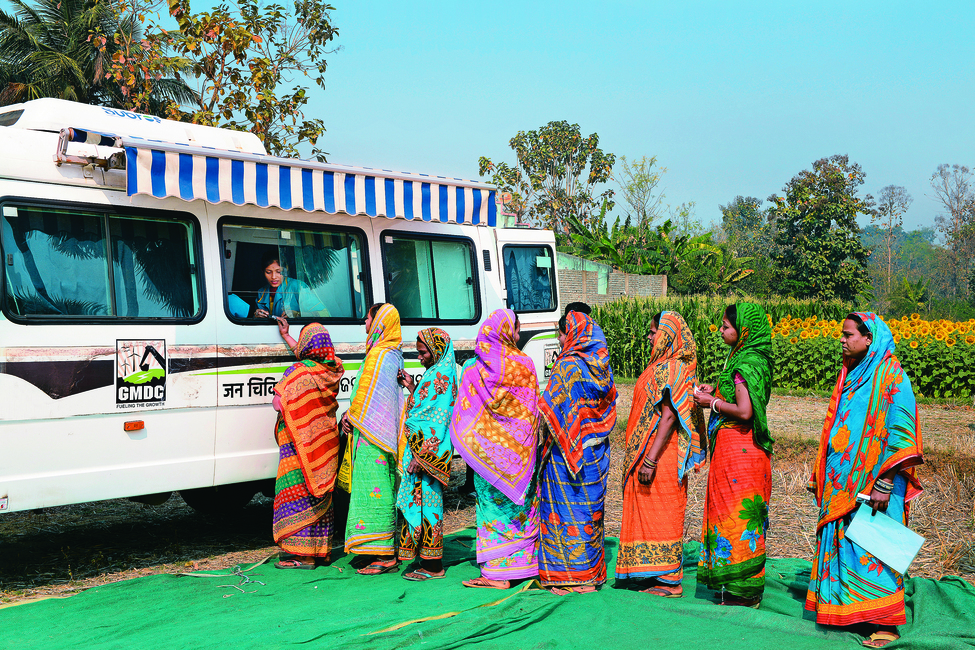
Women lining up for the MMU registration, bringing essential healthcare to remote communities through GMDC’s initiative
With GMDC’s focus on sustainability, education, healthcare, skill development, and sanitation and hygiene, Managing Director, Mr Roopwant Singh, IAS talks about what drives the mining major’s CSR strategy. Edited excerpts:

GMDC adopts an integrated approach to community development. The Gramya Vikas Trust (GVT) CSR implementing body of GMDC has undertaken several high-impact CSR initiatives aimed at enhancing socio-economic conditions in rural and tribal communities across Gujarat. These initiatives are designed as a comprehensive, interdependent ecosystem to create long-term community resilience and economic stability. GMDC-GVT uses innovative partnerships and programmes, strategic collaborations and stakeholder engagement of communities to enhance the quality of life at the local level.
The Samarthya programme serves as a critical bridge between education and employability, ensuring that students benefiting from educational and nutritional support can transition into stable, income-generating careers. About 92% of trainees reported improved self-reliance and 67% experienced better financial stability. The programme also ensures good governance and transparency through an IT-based monitoring system, well-defined KPIs for tracking PIA performance online, and unique IDs for candidates to prevent duplication.
The Jan Chikitsa Seva initiative has been instrumental in bringing essential healthcare services to remote communities through Mobile Medical Units (MMUs), serving over 80,000 beneficiaries across 230 villages. As many as 2,274 health camps have been organised till date. The initiative also provided medical consultation and referrals to 1,11,854 people and dispensed 1,03,477 medicines, free of cost. The initiative makes available diagnostic testing in remote areas of Gujarat and Odisha, conducting more than 23,000 lab tests. A key highlight of the project is its gender impact, with women constituting 58% of beneficiaries, reinforcing gender-sensitive healthcare access and ensuring that women and children, often the most vulnerable in rural communities, receive timely medical care.
GMDC’s CSR initiatives in Odisha are driving sustainable community development across Sundargarh and Angul districts. GMDC-GVT organised 437 health camps and provided 15,664 medical consultations. The community also received more than 15,000 medication and 2,664 lab tests free of cost. Under the Samarthya programme, 150 candidates enrolled in various non-traditional trades, of which training of 60 students have been completed. By developing rural infrastructure such as roads, community halls, and streetlights, we enhance connectivity, safety, and social cohesion, improving the overall quality of life. Additionally, our education support programme has had a positive impact on school enrolment, reduced dropout rates, and motivated children to pursue their education. GMDC-GVT distributed notebooks to 2,376 students across 21 schools.
GMDC-GVT focusses on renewable energy, water conservation, afforestation, and biodiversity preservation to minimise our ecological footprint. The Water Conservation Project has reduced economic vulnerability by ensuring yearround access to water, enabling multi-crop farming and higher crop yields. Additionally, the Smruti Van Project, which has planted 3,73,952 saplings, has improved soil health, groundwater (Above) Women lining up for the MMU registration, bringing essential healthcare to remote communities through GMDC’s initiative retention, and climate resilience.




